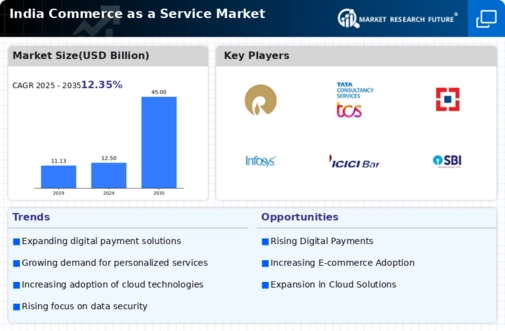The commerce as-a-service market in India is currently characterized by a dynamic competitive landscape, driven by rapid digital transformation and increasing consumer demand for seamless online shopping experiences. Major players such as Shopify (CA), BigCommerce (US), and Salesforce (US) are strategically positioning themselves to capture market share through innovative solutions and robust service offerings. Shopify (CA), for instance, focuses on empowering small to medium-sized enterprises (SMEs) with user-friendly tools that facilitate e-commerce setup and management. Meanwhile, Salesforce (US) emphasizes its customer relationship management (CRM) capabilities, integrating them with commerce solutions to enhance customer engagement and retention. Collectively, these strategies contribute to a competitive environment that is increasingly centered around customer-centric innovations and technological advancements.
In terms of business tactics, companies are increasingly localizing their operations to better serve the Indian market. This includes optimizing supply chains and tailoring services to meet local consumer preferences. The market structure appears moderately fragmented, with a mix of established players and emerging startups vying for attention. The collective influence of key players is significant, as they drive trends in service offerings and customer engagement strategies, thereby shaping the overall market dynamics.
In October 2025, Shopify (CA) announced the launch of a new localized payment gateway specifically designed for Indian merchants, which is expected to streamline transactions and enhance user experience. This strategic move not only addresses the unique payment preferences of Indian consumers but also positions Shopify as a more attractive option for local businesses looking to expand their online presence. The introduction of this payment solution could potentially increase Shopify's market penetration in India, reflecting its commitment to understanding and catering to local needs.
In September 2025, BigCommerce (US) expanded its partnership with local logistics providers to enhance its fulfillment capabilities in India. This initiative aims to reduce delivery times and improve customer satisfaction, which are critical factors in the competitive e-commerce landscape. By aligning with local logistics firms, BigCommerce (US) demonstrates its strategic focus on operational efficiency and customer service, which are essential for maintaining a competitive edge in the market.
In August 2025, Salesforce (US) unveiled a new AI-driven analytics tool tailored for Indian retailers, designed to provide insights into consumer behavior and purchasing patterns. This tool is expected to empower businesses to make data-driven decisions, thereby enhancing their marketing strategies and operational efficiencies. The integration of AI into commerce solutions signifies a broader trend towards leveraging technology for competitive differentiation in the market.
As of November 2025, the most pressing trends shaping competition in the commerce as-a-service market include digitalization, sustainability, and the integration of AI technologies. Strategic alliances among key players are increasingly prevalent, as companies seek to enhance their service offerings and operational capabilities. Looking ahead, competitive differentiation is likely to evolve, with a shift from price-based competition towards innovation, technology adoption, and supply chain reliability. This transition underscores the importance of agility and responsiveness in meeting the ever-changing demands of consumers.

















Leave a Comment